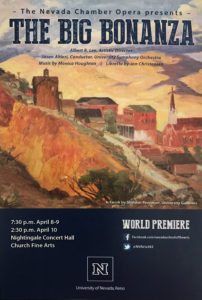THE BIG BONANZA
An opera by Monica Houghton in two acts with a libretto by Jon Christensen
Premiered by Nevada Chamber Opera on April 8, 9 and 10, 2016 Albert Rudolph Lee, Director; Jason Altieri, Music Director
Synopsis
Set in Virginia City, Nevada, at the time of the discovery of the legendary Comstock Lode, this ensemble piece brings to life an important chapter in the history of the American West with a libretto and score drawing upon actual writings and tunes of the times. The central character is a newspaper man and through his interactions with other characters on stage we are led to weigh in our own minds important facets of American life and character that remain relevant today.
Running time: one and a half hours including intermission
Main Characters
- William Wright, alias Dan De Quille (baritone)
- Caroline, his wife (lyric soprano)
- John Mackey (bass)
- Samuel Clemens, alias Mark Twain (tenor)
- Julia Bulette (dramatic soprano)
- The Barmaid (mezzo-soprano)
- Zhang (bari-tenor)
- Jean Millean (tenor)
- The Pickboy (treble)
Additional characters are drawn from the ensemble. A complete breakdown of scenes charted by character appearance is available: The Big Bonanza Personnel
Instrumental forces
32 piece chamber orchestra, erhu, on-stage concertina
Musical Style
tuneful, w/ expressive singing, colorfully orchestrated, imaginative use of percussion instruments
Structure of the Work with Scene Descriptions
NB: Audio selections that follow are from a concert reading with piano accompaniment only (Steven Byess, Music Director; Eric Charnofsky, piano)
Act I
Prelude
Scene 1: The curtain rises on Virginia City, Nevada, in full throttle circa 1860. The young mine owner John Mackay entices Dan, now a reporter for the local newspaper The Territorial Enterprise to come down into his mine to see the hot prospects.
Interlude 1 orchestral music depicting Dan descending into the mine
Scene 2: Inside the steamy tunnels deep underground, the toiling, shirtless miners sing of the hazards they face there. A boy soprano sings of the worst of all perils–a fire in the mine.
Interlude 2 orchestral music depicting Dan ascending from the mine
Scene 3: Dan meets his junior colleague, the young Mark Twain, in a lively bar. A séance is underway as the two men take turns dancing with Julia Bulette.
Scene 4: In the office of The Territorial Enterprise, Dan finds a letter from Caroline, but sets it aside to work on his article about the mine, pausing at one point to reflect upon the beauty and grandeur of the desert landscape. When at last he picks up the letter, we hear Caroline sing of how she misses Dan.
Interlude 3 “The Zephyr Waltz”
Scene 5: Dan meets Julia outside her crib (house). Lamenting the absence of a woman in his life, his words become rambling and bizarre. Julia then sings an aria about the barrenness of her own life, at the end of which an unknown assailant murders her.
Act II
Scene 6: A chorus of townspeople is picnicking below a gallows. Mark Twain, now famous and living back East, has come to observe the hanging. Seeing that Dan has fallen on hard times, he suggests that his friend should escape the confines of the Comstock for a broader view of life. Jean Millean, the French- man convicted of Julia’s murder, proclaims his innocence to the end, even as the crowd chants, “Death to the Villain!”
Scene 7: Seeking oblivion inside an opium den, Dan remembers an evening when Caroline sang to him beneath the moon. The den owner, a Chinese named Zhang, sings about his own journey, coming to Gold Mountain to seek his fortune far from home. As if in a dream, desert creatures emerge from the darkness to dance a slow quadrille as dawn arrives.
Interlude 4
Scene 8: Dan rushes into the Washoe Club to conduct an interview with John Mackay, now a wealthy mining mogul, for his forthcoming book The Big Bonanza. Mackay holds forth on the issue of the day: making money. Dan then shifts his attention to a meeting of the fledgling Miners’ Union that is underway across the street. The miners are deciding whether or not to continue working in unsafe conditions.
Interlude 5
Scene 9: Alone at his desk in the middle of the night, Dan is putting the finishing touches to his book. He fingers an unopened letter from Twain (who has now become his publisher) then passes out at his desk. A fire breaks out in the town, and Dan rushes into the mayhem. John Mackay weighs whether to save the church or the mines: “The mines must be saved,” says Mackay famously.
Interlude 6
Scene 10: Dan is recuperating in a hospital in Virginia City when he receives a letter with bad news con- cerning the sales of his book. Twain, from his desk in Connecticut marvels at Dan’s decline, while Caro- line, standing alone in an Iowa cornfield is still wondering if Dan will ever come home to her, even as Dan refuses to believe that the boom is over, in his memory he sees Mackay pointing to the glittering lode as he sings, “The Comstock will be back again!”
For further information on licensing of scenes presentations please contact the composer: click here
Development History
Orchestral Reading of Prelude and Scene 1 Cleveland Institute of Music, December 2001
Orchestral Reading of Scene 2
Cleveland Institute of Music, December 2002
Staged Performances of Scene 3 and 4
Cleveland Institute of Music (Gary Race, Director) February 2003
Reading of Scene 7
Shanghai Conservatory of Music, China, May 2004
Readings of Scene 5 and Scene 8 up to the Miners’ trio
Virginia Arts Festival John Duffy Composer Institute, Norfolk, Virginia, May 2006
Staged Performance of Scene 10
Oberlin College (Jonathon Field, Director) May 2007
Concert Reading of the entire opera with piano Self-produced (Steven Byess, Music Director) June 2008